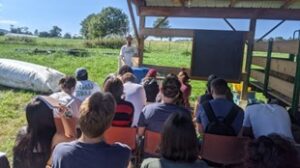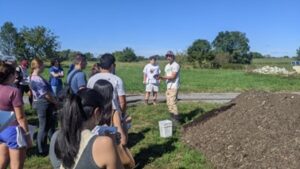Field Trip to DCF: Waste to Energy in the Food System – Bennett Greenspoon
The Dickinson College Farm is more than a venue for students and staff to grow organic food; it is also a focal point for sustainable practices, integrating innovative solutions into the food system. It is part of a growing movement that explores “waste to energy” strategies, turning what would be food waste into energy. Among such technologies is biogas systems, through which organic waste is transformed into biogas, a renewable energy source that can be used for heating, cooking, and even electricity generation (M. Steiman, personal communication, October 3, 2024).
Halpin, J. (2024) Dickinson College Farm
Biogas production involves anaerobic digestion of organic material, such as food scraps, manure, and other biodegradable waste (M. Steiman, personal communication, October 3, 2024). Microorganisms break down the material in the absence of oxygen, resulting in the production of methane, or biogas, along with a nutrient-rich by-product called digestate (M. Steiman, personal communication, October 3, 2024). This biogas can then be harnessed as a sustainable energy source. Meanwhile, the digestate can also be used as a fertilizer, adding another layer of sustainability to the process. This closed-loop system reduces waste, reduces methane emissions from landfills, and provides a renewable energy alternative (Subramanian, Brown, & Dziedzic, 2019).
According to “Women and Home-Scale Biogas: Benefits, Barriers and Insights from US-based Innovators,” (Steiman, 2019) there is significant potential for biogas systems, particularly at smaller, home-scale levels. Women have been at the forefront of many biogas innovations, promoting it as a way to decentralize energy production and address environmental challenges (Steiman, 2019). Home-scale biogas systems allow households to convert kitchen scraps and garden waste into energy, reducing reliance on traditional fuels like natural gas or propane (Steiman, 2019).
Biogas technology is used at the Dickinson College Farm with broader goals of sustainability and education. Food waste can be repurposed into energy through processes that students can observe, such as the repurposing of the dining hall food waste, affording them practical knowledge about waste-to-energy systems to carry forward into their careers. The farm’s biogas initiatives present a tangible example of how small-scale biogas systems can reduce carbon footprints while bringing in various economic and environmental benefits.
While the benefits are clear, “Women and Home-Scale Biogas” (Steiman, 2019)also notes barriers, which include initial setup costs and learning associated with maintaining biogas systems. However, through innovation, education, and public awareness, these challenges are being brought under control (Subramanian et al. 2019; Steiman 2019). With the continued development of user-friendly systems and proof of their potential at sites like the Dickinson College Farm, there is at least some hope for biogas to play a much more significant part in changing the food system’s relationship with both waste and energy.
 Halpin, J. (2024) Dickinson College Farm
Halpin, J. (2024) Dickinson College Farm
The farm’s commitment to integrating biogas into its operations is an exciting step forward for sustainable agriculture, and it provides a blueprint that institutions and individuals can emulate.
References:
- Steiman, M. (2019). Women and home-scale biogas: Benefits, barriers and insights from US-based innovators. Dickinson College Farm.
- Subramanian, M., Brown, L., & Dziedzic, G. (2019). Women and home-scale biogas: Benefits, barriers and insights from US-based innovators, BioEnergy Research.
